-
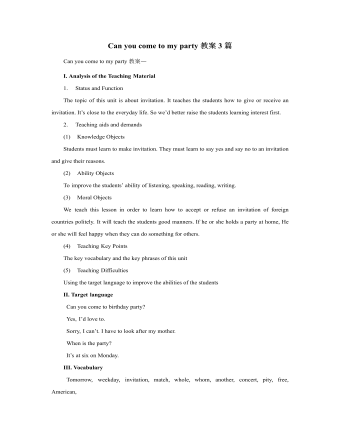
人教版新目标初中英语八年级上册Can you come to my party教案3篇
Step 3 (3b)First, tell the students when we talk about our future plans, we often use: I’m+verb+ing When we talk about what we must do, we use have to. Ask the students to fill in the blanks in 3b. The answers are: shopping, go to see, a test, I’m going, my family. Step 4 (3c)Let the students write an e-mail message to a friend. Say why you can’t visit next. Before the exercise, ask the students to give some possible answers and write them on the blackboard. So the students will feel easy to finish the writing exercise. After they finish it, Let them to correct it in groups first. Each group chooses theirs best one to read in front of the whole class. Step 5 ( planning a party )First read the conversation in the box together. Then ask the students to turn to page 88.Write down everything you have to do next week. Write in all the things you have to do . Ask the students to look at the list. Ask them “What day are you free?” This is when you can have your party. Step 6 (Self check 1 )Let the students to fill in the blanks with the words given. Change the forms of the words if possible. Then make their own sentences. The answers are: visit, playing, have to, study, comeStep 7 (Self check 2)Imagine you are Marie. Read the information and look at your schedule. Write replies to the invitation.
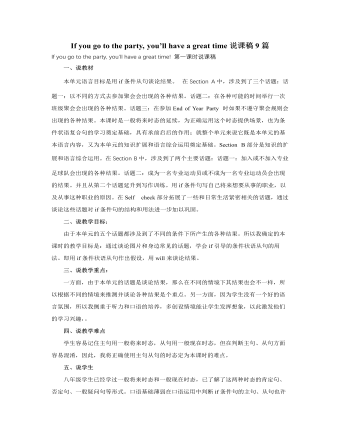
人教版新目标初中英语八年级下册If you go to the party, you’ll have a great time说课稿9篇
二、说教学目标:由于本单元的五个话题都涉及到了不同的条件下所产生的各种结果。所以我确定的本课时的教学目标是:通过谈论图片和身边常见的话题,学会if引导的条件状语从句的用法。即用if条件状语从句作出假设,用will来谈论结果。三、说教学重点:一方面,由于本单元的话题是谈论结果,那么在不同的情境下其结果也会不一样,所以根据不同的情境来推测并谈论各种结果是个重点。另一方面,因为学生没有一个好的语言氛围,所以我侧重于听力和口语的培养,多创设情境能让学生发挥想象,以此激发他们的学习兴趣,。四、说教学难点学生容易记住主句用一般将来时态,从句用一般现在时态,但在判断主句、从句方面容易混淆,因此,我将正确使用主句从句的时态定为本课时的难点。

人教版新目标初中英语八年级上册How was your school trip教案2篇
“Go for it!” is based on “Task-Based Language Teaching”. It adheres to “The authenticity principle”, “The form-function principle”, “The task dependency principle” and “The principle of learning by doing”. These principles all accord with the demands of curriculum focus.In and of Grade Seven (II), “Go for it!”, students have learned “The Simple Past Tense”. And it appears again in of Grade Eight (I). teaches students more about how to talk about events in the past. In addition, it gives affirmative and negative statements in the past tense, such as the sentence patterns “Did you see …?” “Were there …?” “Did you go …?” As the first part of Unit 8, Section A opens with a picture presenting the last school trip in the aquarium and continues with several step-by-step practice activities, which are all good for students to master “The Simple Past Tense”. Doing well in Section A will help students integrate the new target language with that in Section B. Thus, they can describe the events in the past freely and foster their own ability of reflecting and practicing. II. Teaching ObjectivesTeaching objective is the beginning and aim of teaching activities. According to the overall goal of the English elementary course--- improve students' synthetic ability of language application, which should be based on the development of students’ “Language knowledge”, “Language skills”, “Character building”, “Learning strategies” and “Cross-cultural awareness”. The teaching objectives are described as follows(I). Knowledge objectivesi. Master the simple past tense of regular and irregular verbsii. Recite the new words and expressions about the last school trip in the aquarium, including their pronunciation and intonation

人教版新目标初中英语八年级下册Have you ever been to an amusement park说课稿7篇
1. 教材的地位及作用:本单元围绕谈论过去的经历,学习使用现在完成时态。通过对学生们喜闻乐见的一些娱乐场所(fun places)的描述,反复运用句型Have you ever been to…? I’ve never been to…. 来激发他们使用本单元所学单词的兴趣。教材中提供的所有活动都以现在完成时态为中心,通过一系列的听、说、读、写的训练,来加深对现在完成时态的理解,明白英汉两种在结构及表达方法的一些异同点。从而提高他们运用所学语言的综合能力。2. 教材的结构本单元分Section A 和Section B 两部分。Section A 中通过所设计的各项任务呈现了两篇听力课文和一篇阅读理解。Section B则安排了一篇听力和两篇小短文,用以加强对目标语言的理解。Self Check 部分是用来检查学生对本单元所学目标语言的综合运用能力。单元后的语篇训练旨在通过目标语言培养学生的阅读理解能力,掌握一些基本的阅读技巧。3. 教学目标(知识目标、能力目标、情感目标)
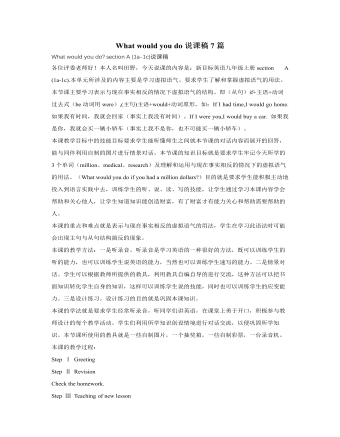
人教版新目标初中英语九年级上册What would you do说课稿7篇
Get students to complete the activity in groups of four. As the groups work together, move around the room to make sure students discuss the topic in English and know how to fill in the chart.Check the answers by asking different pairs of students to say their conversations to the class.Answers will vary.Optional activityAsk, What would you do if there were no classes tomorrow? Ask students to write as many answers as they can. Then get students to work in pairs. One ask the other the question and see how many new answers the other is able to think of.Step Ⅴ SummarySay, In this class, we've done a lot of reading, speaking and writing practice using the target language.Step Ⅵ Homework(1) Review the target language by reading the conversations in Activity 3a.(2) Finish off the exercises on pages 11~12 of the workbook.Step Ⅶ Blackboard DesignWhat would you do?Section AThe Third PeriodTarget language:A: I can't sleep the night before an exam. Then I'm too tired to do well. What should I do?B: If I were you, I'd take a long walk before going to bed. That should help you relax.A: I really want a dog, but my parents won't let me have one.B: Well, dogs can be a lot of trouble. Maybe you should get a small pet, like a goldfish.A: That's a good idea.
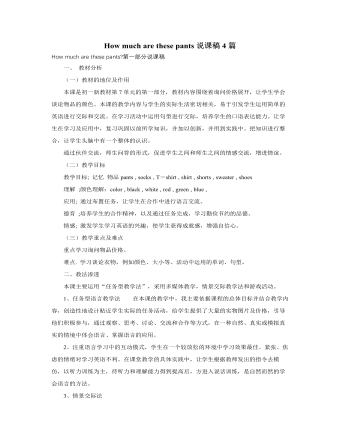
人教版新目标初中英语七年级上册How much are these pants说课稿4篇
3)情感目标在活动中培养学生的协作精神和竞争意识,培养学生学习英语的积极情感态度。同时教育学生要好好珍惜现在的学习机会,并养成勤俭节约的好习惯。3. 教学重点及难点根据本课在教材中的地位、作用及学生实际,我把“询问价格”及“购物时使用的礼貌用语”定为该课的重点和难点。二、教法根据教学目标、教材特点及学生的心理和年龄特征,我主要采用了任务型语言教学模式。创造性地设计了贴近学生实际生活的教学活动,吸引和组织他们参与交际活动,大大地激发了他们学习英语的兴趣,让他们在完成任务的同时,体验成功的喜悦。三、学法学习指导的目的在于使学生愿学、乐学、主动学、会学,在于促进学生的个性发展和全面发展。因此,在教学上,通过多媒体及活动等多种形式,教给学生观察事物的方法,并让学生在学中用,用中学。
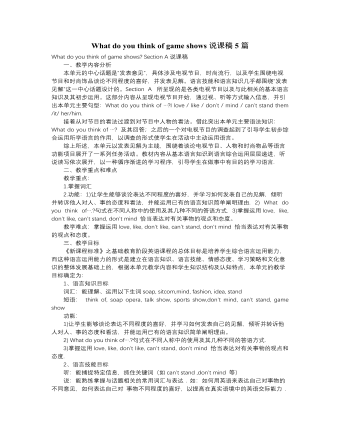
人教版新目标初中英语七年级下册What do you think of game shows说课稿5篇
步骤二 看图学单词我把本单元有关的单词制成图片显示在屏幕上。目的在于通过直观的画面效果和有意义的情景,便于学生更快地把单词的声、形和意联系起来。使学生轻松地掌握这些单词的音、形、义,且充分调动了学生的学习热情,让学生在思考中理解所学的生词。如 sitcom( situation comedy)1.猜。点击屏幕上一副有关情景喜剧的图片。说This is s kind of funny show. We call it sitcom. The people in sitcoms do or say things that make Tv watchers laugh.让学生根据图片和教师的提示猜出单词的意思。这时再告诉学生们sitcom=situation comedy.一定会有很多同学争先恐后地抢答,我们可以挑三个不同层次的学生起来回答,这样做既发挥了优等生的带头作用,同时为待优生树立起学好英语的信心,又增强了其他同学的竞争意识(他会我也会),也融入了教师的情感价值观之中。
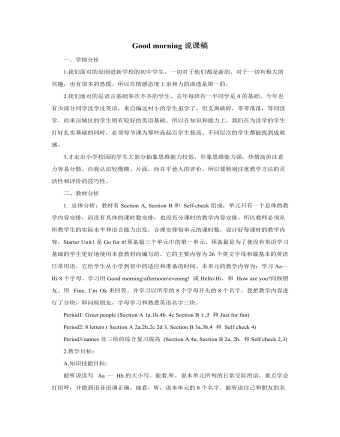
人教版新目标初中英语七年级上册Good morning说课稿
1.课堂活动中的竞赛制:以记奖评优的形式无声的评价每一个活动,包括个体和小群体。在第一课时评最佳演员和导演奖,第二课时评最佳团体奖,既节约时间又明确有效。使学生能提高语言质量,增强参与意识,提高学习兴趣。2. 教师课堂上语言、表情激励制:在课堂活动中教师要乐于 、善于用激励性语言。从good, super, smart, excellent , great ,wonderful等,用微笑,皱眉,摇头、点头等身体语言对于学生的评价是方便又有效的途径。3.课后作业评价:口头作业在第二天课堂上表演,接受全体同学的评价。笔头作业有教师批阅,以评语的方式出现。优秀作业予以展出或交流。积极地肯定和鼓励学生是我们评价的重要目的之一。4.单元结束后综合性评价:除了笔试以外,也可以根据学生实际开展丰富的活动,如:调查报告、小品表演、专题演讲等。
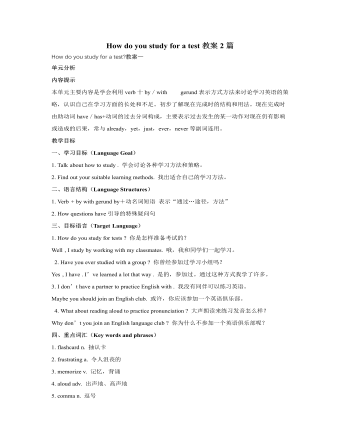
人教版新目标初中英语九年级上册How do you study for a test教案2篇
内容提示本单元主要内容是学会利用verb十by/with gerund表示方式方法来讨论学习英语的策略,认识自己在学习方面的长处和不足。初步了解现在完成时的结构和用法。现在完成时由助动词have/has+动词的过去分词构成,主要表示过去发生的某一动作对现在仍有影响或造成的后果,常与already,yet,just,ever,never等副词连用。教学目标一、学习目标(Language Goal) 1. Talk about how to study . 学会讨论各种学习方法和策略。2. Find out your suitable learning methods. 找出适合自己的学习方法。 二、语言结构(Language Structures) 1. Verb + by with gerund by+动名词短语 表示“通过…途径,方法” 2. How questions have引导的特殊疑问句 三、目标语言(Target Language) 1. How do you study for tests ? 你是怎样准备考试的?Well , I study by working with my classmates. 哦,我和同学们一起学习。2. Have you ever studied with a group ? 你曾经参加过学习小组吗?Yes , I have . I’ve learned a lot that way . 是的,参加过。通过这种方式我学了许多。
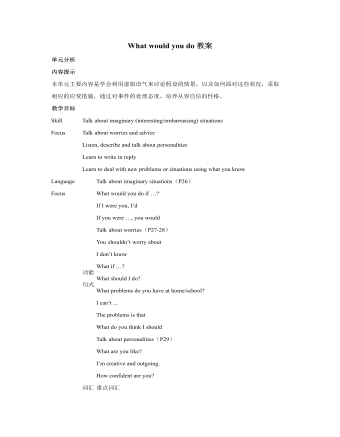
人教版新目标初中英语九年级上册What would you do教案
本课采用任务型教学法,用What would you do if you had a million dollars?这个问句,引出谈论假想情况的话题。 采用提问、启发和归纳的教法,让学生易于接受教材内容,培养学生的语言运用能力。 四、 教学过程设计 Step Ⅰ. Greet the whole class as usual. Step Ⅱ. Warming-up T: Do you have ten Yuan in your pocket? S1: No, I don’t. T: (Take out ten Yuan and give it to the student) OK, never mind. What would you do if it was yours? What would you do if you had ten Yuan? S1: I would buy snacks. T: OK, thank you. Sit down, please. (To the whole class) Just now, it was only ten Yuan. What about 100 Yuan? What would you doif you had 100 Yuan? S2: I’d buy a beautiful jacket. T: Thank you. (To the whole class) Now suppose you had a million dollars, what would you do? We know thatone dollar nearly equals eight Yuan, so that’s a large sum of money. Think it over carefully and tellme your ideas. What would you do if you had a million dollars? S3: I’d buy a big house. S4: I’d buy a sports car. S5: I’d put it in the bank. T: OK, stop here. Please look at the blackboard and guess what would I do if I had a million
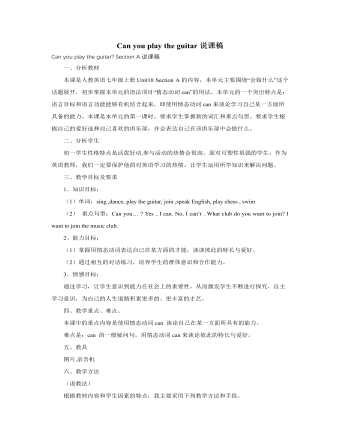
人教版新目标初中英语七年级上册Can you play the guitar说课稿
教材分析1、教材地位作用本单元围绕着学习情态动词can 的用法,来表达自己在某一方面所具有的能力。2、教学目标(知识目标、能力目标)(1)知识目标:复习情态动词can 的用法。(2)能力目标:通过学习can ,达到能灵活谈论自己的喜爱与特长,培养一种群体意识。3、重点和难点:(1)重点:情态动词can的一般问句的用法。(2)难点:利用上下文语境及略读技巧。二、教法:让学生默读课文(限时),让学生在短时内抓住课文的重点,划出关键词,从中亲自感受一下略读的技巧,然后老师加以指导。三、学情与学法针对学生在不理解情态动词can 的一般问句的情形下,反复阅读课文,从而加深对本单元前两页所学can用法的印象,从中真正感悟can的用法.
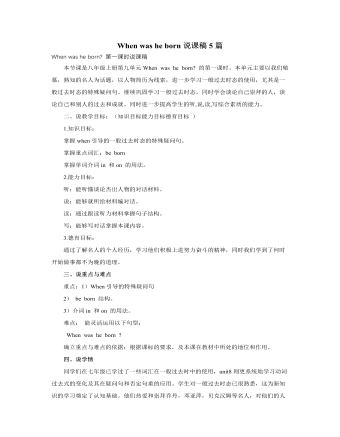
人教版新目标初中英语八年级上册When was he born说课稿5篇
1. 教学重点(1)新单词及目标语言的掌握。(2)听、说、读、写的综合训练。(3)对对合作及小组合作练习口语的训练。2. 教学难点(1)when所引导的特殊疑问句。(2)询问生日与出生年月日的区别。When is your birthday? (一般现在时)When were you born?(一般过去时) (3)表达年月日时所用的不同介词:in+年/月;on+日期二、教学方法。由浅入深,由易到难,由已知到未知,从学生熟悉的运动明星、电影明星甚至是歌手入手,调动他们的学习积极性,让他们在心情愉快、兴趣浓厚的氛围中展开一系列听说读写的训练,主动地投入到学习中去,自然地掌握本单元的重点、难点;循序渐进地深化教学内容,同时以训练学生听说为主,展开以老师为主导,以学生为主体的师生双边互动活动。三、教学手段。利用名人图片来辅助新的语言知识的巩固和训练;采用多媒体教学,并把听力内容录到电脑中,锻炼了学生的视听能力,提高了教学效果。
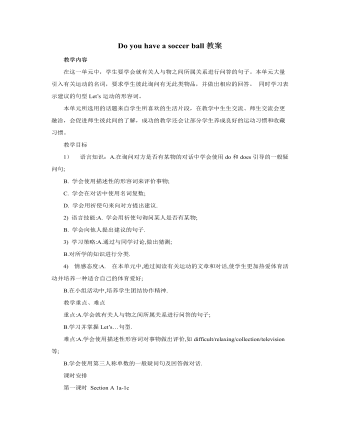
人教版新目标初中英语七年级上册Do you have a soccer ball教案
在这一单元中,学生要学会就有关人与物之间所属关系进行问答的句子。本单元大量引入有关运动的名词,要求学生彼此询问有无此类物品,并做出相应的回答。 同时学习表示建议的句型Let’s运动的形容词。 本单元所选用的话题来自学生所喜欢的生活片段,在教学中生生交流、师生交流会更融洽,会促进师生彼此间的了解,成功的教学还会让部分学生养成良好的运动习惯和收藏习惯。 教学目标 1) 语言知识:A.在询问对方是否有某物的对话中学会使用do和does引导的一般疑问句; B. 学会使用描述性的形容词来评价事物; C. 学会在对话中使用名词复数; D. 学会用祈使句来向对方提出建议. 2) 语言技能:A. 学会用祈使句询问某人是否有某物; B. 学会向他人提出建议的句子. 3) 学习策略:A.通过与同学讨论,做出猜测;
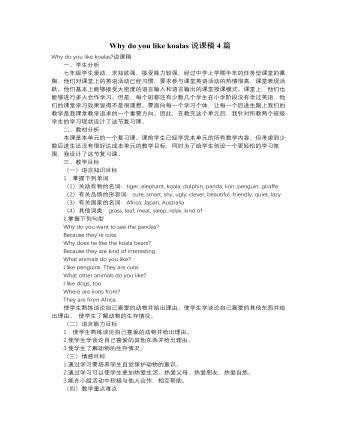
人教版新目标初中英语七年级下册Why do you like koalas说课稿4篇
通过Go for it七上的学习,大部分学生对why/what/where引导的特殊疑问句已具备较强的听说能力,而本单元围绕“animals”的教学活动贴近学生生活,学生有强烈的兴趣和好奇心,使他们产生了解的欲望,有利于引导他们自主学习。本单元的教学内容我是用了三节课完成,又用了第四节来复习。七班的学生大部分性格偏内向,不喜欢表达和展现自己,但大部分同学有一定的英语基础,通过教师的恰当引导,能完成教学任务。教材分析:本单元的topic是animals, 要求学生掌握一些新的动物名词,学会用表示性质和品质的形容词来描述动物,并能用“Why do you like…? Because….” 来陈述喜欢的原因。通过讨论动物,让学生了解大自然,增长地域知识,增进对自然环境的情感;通过讨论自身的喜好及原因,提高学生的认知和思维能力。教材在第一、第二单元的基础上对已有的语言项目进行拓展,符合学生的认知规律,循序渐进。

人教版新目标初中英语八年级上册What’s the best radio station说课稿6篇
3、重点和难点:重点:学会用形容词的最高级来对事物或人物进行描述。难点:形容词的最高级加est还是加most.二、 说教法:为了更好的突出重点,突破难点,我主要采用了:1、任务型教学法:新课标倡导的“玩中学,学中玩”的理念很受学生欢迎。例如,阅读文章时,我设计了一张表格,让学生阅读后完成表格并复述。培养学生逻辑分类与表述能力。2、 竞赛教学法:根据初中生争强好胜的性格特征,我每堂课都进行俩俩对话,激发学生兴趣,给学生创造外语语言氛围,培养学生集体荣誉感。三、说学法:1、 善于抓住用英语交际的机会,充分感知,积极体验,大胆实践。例如在导入新课时的One minute dialogue(每组都有一次机会),pairwork (每人都有机会),groupwork(每组一次机会)。2、 积极参与,善于合作。例如本课设计了几个任务,操作简单,学生一定很感兴趣并且积极参与,从而合作完成任务,培养了团队精神。
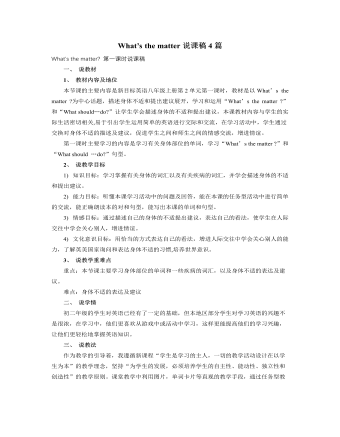
人教版新目标初中英语八年级上册What’s the matter说课稿4篇
在任务环活动中,我通过设计不同的四个任务,让学生在小组中交流、合作、竞争,每个任务都存在着一定的“信息差”,易于激发学生的表达欲望和急于知道最终结果的心情,在活动中他们一定会努力表现自己,做到最好。四个任务所侧重的训练学生的语言能力的要求也各有不同,他们分别侧重训练学生的听、说、读、写的能力。把任务活动放在小组中进行,还可以解决“大班”难于操练的难题,学生在小组中有更多的时间来运用英语表达自己的思想。Post-task任务后活动(4”)1. Grammar Focus(2”)Go through the Grammar Focus with the whole class,ask Ss to point out the main points in this period. Then show the use of The Past Tense on the screen, especially the regular and irregular changes of verbs. 2. Language practice(2”)Practise the sentence patterns and the use of the Past Tense, especially the errors which Ss made while carrying out their tasks. Such as Subject-verb agreement or Tense-agreement, etc. For example: were you see any sharks? He go to the beach. 在学生尽情地参与活动后再让学生反思本节课的语法焦点,并进行适当的操练,对学生在任务活动中的语言失误进行纠正,使学生保持学习信心。语法讲解采用动画形式又保持了学生的学习兴趣。

人教版新目标初中英语八年级上册I’m going to be a basketball player教案3篇
教学目标1.知识目标:(1)学习What are you going to be when you grow up?/How are you going to do that?句式。(2)学会用英语描述有关职业的表达法。2.能力目标:(1)能够谈论为实现理想所做出的打算和安排。(2)能够谈论未来自己与他人理想的职业及原因。(3)能用英语描述课余时间的活动安排,最终具备表达综合信息的能力。3.情感目标:新学期到来之际,让他们在学习、体育、饮食、特长、读书等方面制定计划,教育学生合理安排自己的课外生活,思考自己的理想职业及适合自己的职业。教学重点、难点本单元的重点为“be going to”表将来,want to be, what,where, when,how引导的特殊疑问句。难点是语言目标的实现。教材分析本单元以I am going to be a basketball player为话题,共设计了三部分的内容:一、Section A该部分有4个模块。第一模块围绕Do you think these jobs are interesting?这一话题展开思维(1a)、听力(1b)、口语(1c)训练;
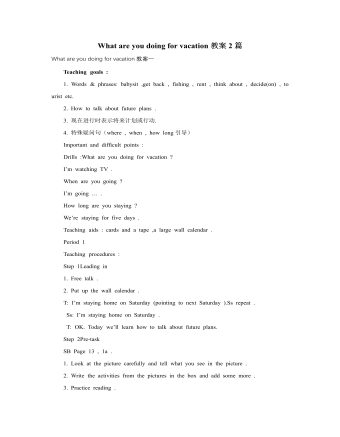
人教版新目标初中英语八年级上册What are you doing for vacation教案2篇
Teaching goals : 1. Words & phrases: babysit ,get back , fishing , rent , think about , decide(on) , tourist etc. 2. How to talk about future plans . 3. 现在进行时表示将来计划或行动. 4. 特殊疑问句(where , when , how long引导) Important and difficult points : Drills :What are you doing for vacation ? I’m watching TV . When are you going ? I’m going … . How long are you staying ? We’re staying for five days . Teaching aids : cards and a tape ,a large wall calendar . Period 1 Teaching procedures : Step 1Leading in1. Free talk . 2. Put up the wall calendar . T: I’m staying home on Saturday (pointing to next Saturday ).Ss repeat . Ss: I’m staying home on Saturday . T: OK. Today we’ll learn how to talk about future plans. Step 2Pre-task SB Page 13 , 1a . 1. Look at the picture carefully and tell what you see in the picture . 2. Write the activities from the pictures in the box and add some more . 3. Practice reading . Step 3While-task1. Using the activities we write in 1a to make conversations .For example :What are you doing for vacation ? I’m visiting my uncle . 2. Pairwork .Practice in pairs . 3. 用第三人称练习对话.
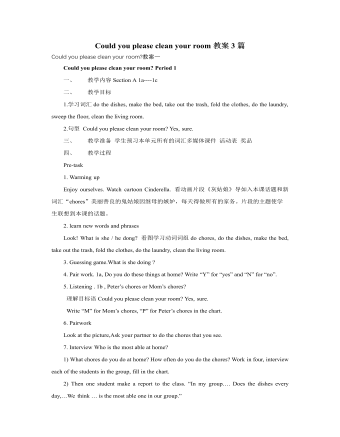
人教版新目标初中英语八年级上册Could you please clean your room教案3篇
一、 教学内容Section A 1a----1c二、 教学目标1.学习词汇do the dishes, make the bed, take out the trash, fold the clothes, do the laundry, sweep the floor, clean the living room.2.句型 Could you please clean your room? Yes, sure.三、 教学准备 学生预习本单元所有的词汇多媒体课件 活动表 奖品四、 教学过程Pre-task1. Warming upEnjoy ourselves. Watch cartoon Cinderella. 看动画片段《灰姑娘》导如入本课话题和新词汇“chores”美丽善良的鬼姑娘因继母的嫉妒,每天得做所有的家务。片段的主题使学生联想到本课的话题。2. learn new words and phrasesLook! What is she / he dong? 看图学习动词词组do chores, do the dishes, make the bed, take out the trash, fold the clothes, do the laundry, clean the living room.3. Guessing game.What is she doing ? 4. Pair work. 1a, Do you do these things at home? Write “Y” for “yes” and “N” for “no”.5. Listening . 1b , Peter’s chores or Mom’s chores?理解目标语Could you please clean your room? Yes, sure.Write “M” for Mom’s chores, “P” for Peter’s chores in the chart.6. PairworkLook at the picture,Ask your partner to do the chores that you see. 7. Interview Who is the most able at home? 1) What chores do you do at home? How often do you do the chores? Work in four, interview each of the students in the group, fill in the chart.
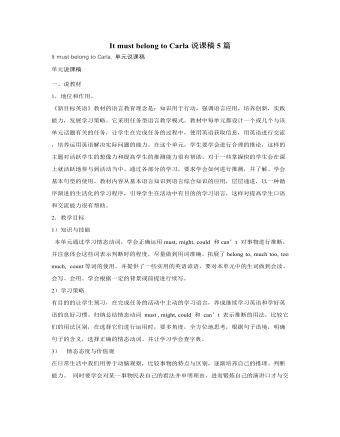
人教版新目标初中英语九年级上册It must belong to Carla说课稿5篇
二、教学目标: 1. 知识目标:要求学生掌握使用表示猜测的情态动词。2. 能力目标:让学生做课堂的主人,同时培养他们掌握一些行之有效的学习方法,优化学习效果。3. 情感目标:让学生爱上英语课堂活动,鼓励他们在课堂上进行合作交流。4.学习策略目标:设法使学生掌握使用英语进行交流,学习积极参与班级活动.三、教学分析:1. 说教法:1)任务型教学法:给学生三项任务, 让学生使用这些情态动词来完成这些任务。使他们在任务中学习英语。2)情景教学法:创造足够的交际环境刺激学生的视听能力,使他们能够更好的理解这些情态动词。以培养他们的听和会话能力。3)交易际教学法:学生可以通过俩俩对话或小组对话来掌握这些情态动词。2. 说学法:1)学生要善于把握机会,用英语进行沟通,大胆实践。





















